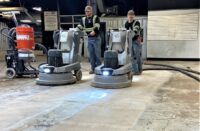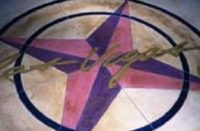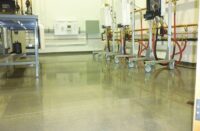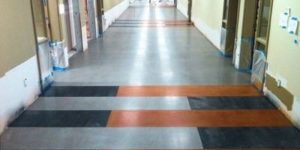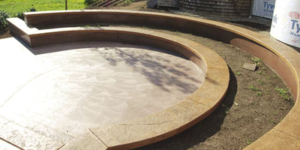
Surfacing Solutions Inc., Temecula, Calif., got a refresher on one central principle of polished concrete as the company produced some 175,000 square feet of densified concrete floor surfaces at the glittering new San Marcos High School in Southern California.
The lesson: Be prepared to improvise. Twists and turns, such as variations in concrete installed at different times, put Surfacing Solutions to the test in formulating grinding and coloring approaches to produce the consistency sought by the design team. Not to mention, there was the arduous task of coordinating work on a grand scale with other construction trades.
Oh, and then there was the weather.
Yes, the weather. It rains in Southern California now and then during the winter months. And rain, open buildings, and dirt and mud from a construction site can produce serious heartburn for finishers of horizontal concrete flooring.
This was a major building program — a whole new high-school complex — to replace an existing school built in the 1960s that had long ago passed its maximum enrollment capacity. The old buildings were razed and classes were held in temporary buildings during construction of new ones. Completion is scheduled for this year, with all buildings occupied in January and conclusion of all site work in August. The construction cost is put at $150 million, with Lusardi Construction Co., San Marcos, serving as general contractor.
The master plan
The 43-acre school site has seen the transformation of a single-story, 2,300-student school campus into a state-of-the-art, multistory educational facility organized around a central quad, according to design architect LPA Inc.’s Irvine, Calif., office. The 412,000-square-foot complex is designed with four specialized academies: Design & Engineering, Environmental Science & Agriculture, Performing Arts and Media Arts.
A singular feature is the student union, designed to reflect what the expanded project statement calls “the collaborative nature of the 21st-century learning environment,” with access to technology, the library, career center, and food services before, during and after school.
With limited site size — unchanged from the existing school — the school district had to build vertically, says David Eaves, LPA associate and project architect. “It’s roughly the same footprint, with a new and different building configuration,” he says.
The district’s utilitarian-minded objective for the polished concrete floors was something less than “total refinement,” says Shawn Halverson, Surfacing Solutions CEO. The goal was attractive appearance, but using only three grinding steps rather than a more extensive, high-reflectance polishing regimen. No color was added, except in problem areas with differences in color due to concrete surfaces that were installed separately.
Spaces to be polished included common areas, corridors and most classrooms. Carpeting, sheet flooring and resinous flooring systems were used in a number of lab and nonclassroom spaces.
A concrete polishing challenge
Surfacing Solutions’ work got underway in late 2012, on the first-floor level of Building C, the athletics building.
“The first day we started grinding, it started raining,” Halverson says. The building lot “became a mudhole, and the floor was covered with mud.”
The crew was pulled off the job, and going forward they worked around periodic rains for the next several weeks. Extensive cleanup of the floors became necessary prior to the start of grinding. “It seemed to rain about every Thursday for a month,” he says. “We worked with the framer, fireproofer and other trades to stay ahead of them.”
The specifications called for a grind with 80-grit metal-bond diamonds, followed by passes with 100- and 200-grit resin-bond diamonds. Then came application of the densifier, the RetroPlate 99 sodium silicate formula from Advanced Floor Products. Diamond grinding was done with the Diamatic BMG-780PRO.
The plan called for a return to the floors after other trades were finished to apply RetroGuard modified acrylic sealer (also from Advanced Floor Products) and burnishing.
Halverson gives credit to general contractor Lusardi Construction for bringing order to spaces where densified concrete was subjected to the work of other trades prior to the sealer-and-burnish phase of concrete polishing.
The polishing was not designed to deliver ultrahigh sheen and reflectivity, “but surprisingly we were getting good reflectance,” Halverson says. The impression was enhanced with the guard product.
Tweaking the color
Though the specifications called for polishing of the concrete without coloring, the plan didn’t go exactly as intended.
The athletics building walls were built using the tilt-up concrete-panel method. This left a strip of floor inside the walls — the pour strip — to be cast later than the building’s main slab. Hand-troweling of these areas resulted in a higher elevation than the main slab, with less density in the concrete and a more wavy surface.
Initially, it was decided to address the issue using Metabo 7-inch grinding tools to flatten the surface along the edges and bring the level into line with the floor slab. This approach, however, exposed too much large aggregate — not what the architect and general contractor wanted to see. “So we had to leave the elevation differences and treat this lip as an edge and polish both the lower and the higher sides individually,” Halverson says — a labor-intensive measure, but the only real solution.
Another issue arose in corridors of Building A, where variations in shading of concrete resulted from pouring of concrete at different times.
The problem was addressed using Westcoat Specialty Coating Systems’ Fast Stain, with different dilutions of the black dye formulated to compensate for varying shades of concrete left from different installations.
“Each time they poured concrete, the color changed, and we had to alter the colorant for each area,” Halverson says. “The concrete was supposed to be the same color, but it varied through the whole project.”
Another solution was necessary to deal with what Halverson calls a “ghosting” effect caused by efflorescence in the lightweight concrete mix used for upper floors in multilevel buildings — Buildings A, C and D. The suspected cause was high water content in the concrete mix.
“When we started polishing, it got worse,” Halverson says of the efflorescence. The problem was largely alleviated by eliminating the sealer application and burnishing step.
Eaves, the LPA project architect, says the efflorescence presented a “cloudy white” appearance, and gives Surfacing Solutions high marks for formulating a solution. “No one was terribly pleased with the efflorescence, but it’s a natural part of the cure process,” he says. “We only see it in the elevated composite decks. On the slabs on grade we continued with the four-step process, with sealer and burnishing.”
Directing traffic
A key to success in this massive project, says Surfacing Solutions superintendent Will Gillette, was management of manpower and logistics — “dealing with multiple buildings, making sure materials and manpower were there when needed, making sure everything was on schedule and on task.”
“The job was so big, going in two and three buildings at a time, sometimes in four, with 12 guys spread out over several buildings,” Gillette says.
Halverson gives a good deal of the credit to Gillette, who “busted it” in managing a massive, complex job spanning a year and then some. Also a key player was director of operations Keith Cantillon, a part owner of Surfacing Solutions.
“Our team from the office and field worked very well in coordinating the process, from our in-office project manager Carrie Brown to Kristen Weisz’s accounting team tracking our production goals, to the field supervisor, Will Gillette,” Halverson says.
In design terms, Halverson says, the San Marcos job was about “function versus fashion,” though he adds that the job still gets points for attractive visuals and craftsmanship in the face of practical constraints.
Halverson says Surfacing Solutions held meetings with the school district’s personnel to review ongoing maintenance procedures, including the use of a product formulated for cleaning that comes with a densifier component.
“We emphasize that polished concrete is inexpensive to maintain,” he says. “But that it’s not maintenance-free — it’s maintenance-simple compared to other types of flooring.
“They spent a lot of money, and deserve to have it last a long time.”
The most practical finish for students
Eaves, LPA project architect, says the school district bought into the architects’ recommendation of polished concrete due to its combination of economics and performance.
“They wanted flooring that was cost-effective and a long-term, low-maintenance flooring system, and that’s exactly what polished concrete provides,” Eaves says. “We think it achieved these goals for the district.
“We worked continually with Surfacing Solutions and the general contractor to go back in some areas where the ultimate outcome was not totally satisfactory,” Eaves says. “They did some additional grinding to get more consistency and some very subtle staining to blend the different colors. This allowed the floors to meet everyone’s expectations. It worked very well in my view, and is ongoing, as the project is not totally complete.”
The overriding factor in the level of polishing specified, Eaves said, was a moderate reflectance level.
“We’ve noticed in classroom environments that if the flooring has very high reflectance, it can be distracting. In this project we have broad window expanses, with a high level of daylighting, and a shiny floor can create glare and similar issues.
“We were not going to try for an auto showroom floor, but something more practical for a school classroom environment.”
Project at a Glance
Client: San Marcos Unified School District, San Marcos, Calif.
Decorative concrete contractor: Surfacing Solutions Inc., Temecula, Calif. | www.surfacingsolutionsinc.com
General contractor: Lusardi Construction Inc., San Marcos, Calif. | www.lusardi.com
Architect/designer: LPA Inc., Irvine, Calif. | www.lpainc.com
Mix design: Robertson’s Ready Mix, North San Diego County, Calif. | www.rrmca.com
Scope of project: About 175,000 square feet of polished concrete floors in new school complex, encompassing four different buildings
Most challenging aspects: Management and logistics of extensive concrete polishing project in multiple buildings, including scheduling of work in conjunction with other construction trades; working with multiple client superintendents; formulation and execution of grinding, polishing and spot coloring processes to address variations in different concrete segments
Products used: RetroPlate 99 densifier and RetroGuard modified acrylic sealer from Advanced Floor Products LLC; Fast Stain powdered dye in black from Westcoat Specialty Coating Systems; Diamatic BMG-780PRO grinder
